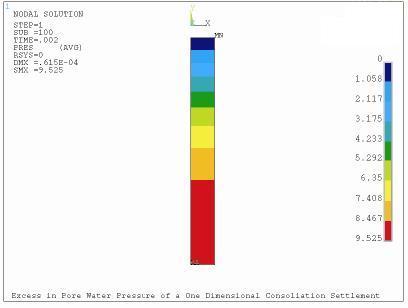VM264
VM264
Terzaghi's One-Dimensional Consolidation Settlement Problem
Overview
Test Case
The problem deals with consolidation of an infinite half-space idealized as a one-dimensional situation. The top surface is permeable and the bottom surface is impermeable. Pressure is applied at the top of a vertically stacked element pile. The distribution of pressure along the depth is computed and compared against reference solution.
| Material Properties | Geometric Properties | Loading |
|
E = 5.8E5 Pa Nu = 0.0 Permeability k=8.62E-3 m/s |
Height H=10m Width W=1m |
Pressure R =10 Pa |
Analysis Assumptions and Modeling Notes
The problem is modeled and solved with two dimensional (CPT213) and three dimensional (CPT215), (CPT216), (CPT217) coupled pore pressure elements. The UZ degrees of freedom in the 3D model are constrained to make it behave like 2D elements. Displacements along X direction are constrained on all nodes and displacements along Y direction are constrained at the bottom surface. The top edge is made pore pressure free (pressure=0). Static analysis is performed with unsymmetric Newton-Raphson option with an end time of 0.02s and the distribution of pore pressure along the depth is computed.
Results Comparison
| 2D 8-Node Couple Pore-Pressure Element CPT213 | |||
|---|---|---|---|
| Y/H (Depth) | P/R (Pre Pressure) | ||
| Target | Mechanical APDL | Ratio | |
| 0. 1 | 0.180 | 0.176 | 0.982 |
| 0.2 | 0.350 | 0.345 | 0.986 |
| 0.3 | 0.500 | 0.497 | 0.996 |
| 0.4 | 0.630 | 0.629 | 0.999 |
| 0.5 | 0.740 | 0.737 | 0.996 |
| 0.6 | 0.820 | 0.820 | 1.001 |
| 0.7 | 0.890 | 0.881 | 0.991 |
| 0.8 | 0.930 | 0.922 | 0.992 |
| 0.9 | 0.940 | 0.945 | 1.006 |
| 1.0 | 0.950 | 0.952 | 1.003 |
| 3D 8-Node Couple Pore-Pressure Element CPT215 | |||
|---|---|---|---|
| Y/H (Depth) | P/R (Pre Pressure) | ||
| Target | Mechanical APDL | Ratio | |
| 0. 1 | 0.180 | 0.181 | 1.008 |
| 0.2 | 0.350 | 0.345 | 0.988 |
| 0.3 | 0.500 | 0.498 | 0.996 |
| 0.4 | 0.630 | 0.629 | 0.999 |
| 0.5 | 0.740 | 0.736 | 0.996 |
| 0.6 | 0.820 | 0.819 | 1.000 |
| 0.7 | 0.890 | 0.880 | 0.989 |
| 0.8 | 0.930 | 0.920 | 0.990 |
| 0.9 | 0.940 | 0.943 | 1.003 |
| 1.0 | 0.950 | 0.950 | 1.001 |
| 3D 8-Node Couple Pore-Pressure Element CPT216 | |||
|---|---|---|---|
| Y/H (Depth) | P/R (Pre Pressure) | ||
| Target | Mechanical APDL | Ratio | |
| 0. 1 | 0.180 | 0.1768 | 0.982 |
| 0.2 | 0.350 | 0.3452 | 0.986 |
| 0.3 | 0.500 | 0.4978 | 0.996 |
| 0.4 | 0.630 | 0.6293 | 0.999 |
| 0.5 | 0.740 | 0.7371 | 0.996 |
| 0.6 | 0.820 | 0.8207 | 1.001 |
| 0.7 | 0.890 | 0.8816 | 0.991 |
| 0.8 | 0.930 | 0.9222 | 0.992 |
| 0.9 | 0.940 | 0.9453 | 1.006 |
| 1.0 | 0.950 | 0.9528 | 1.003 |
| 3D 10-Node Couple Pore-Pressure Element CPT217 | |||
|---|---|---|---|
| Y/H (Depth) | P/R (Pre Pressure) | ||
| Target | Mechanical APDL | Ratio | |
| 0. 1 | 0.180 | 0.173 | 0.963 |
| 0.2 | 0.350 | 0.348 | 0.996 |
| 0.3 | 0.500 | 0.500 | 1.001 |
| 0.4 | 0.630 | 0.631 | 1.002 |
| 0.5 | 0.740 | 0.737 | 0.996 |
| 0.6 | 0.820 | 0.820 | 1.000 |
| 0.7 | 0.890 | 0.881 | 0.991 |
| 0.8 | 0.930 | 0.922 | 0.992 |
| 0.9 | 0.940 | 0.945 | 1.006 |
| 1.0 | 0.950 | 0.952 | 1.003 |



